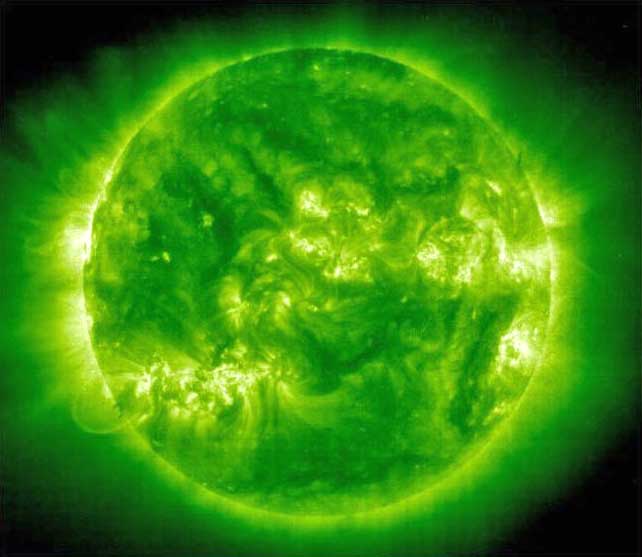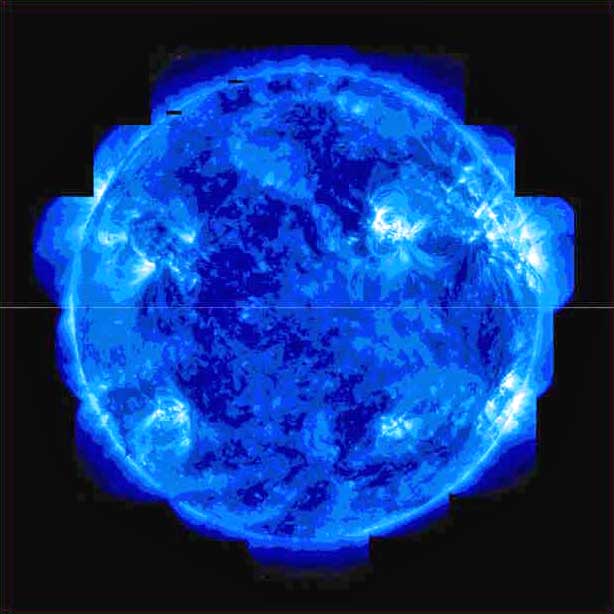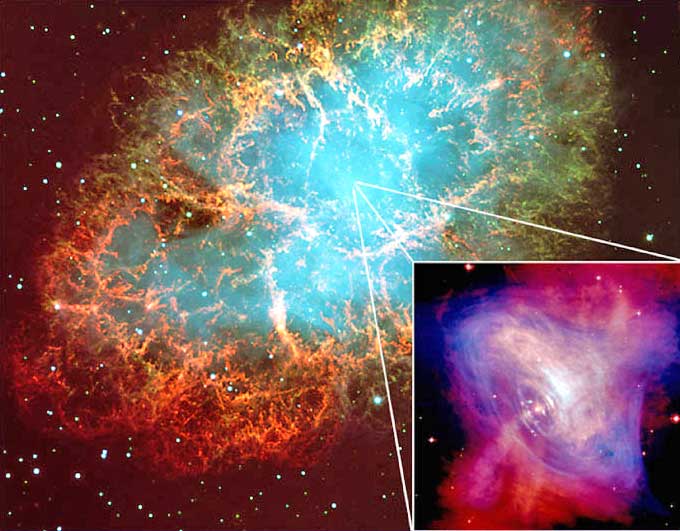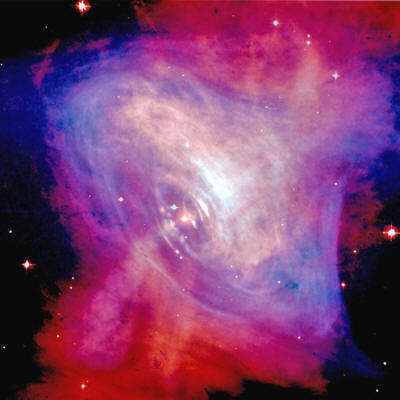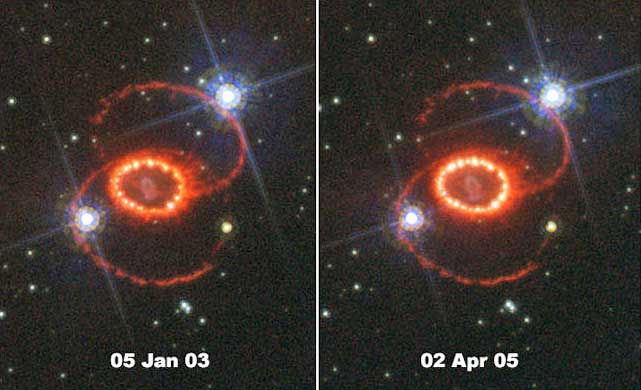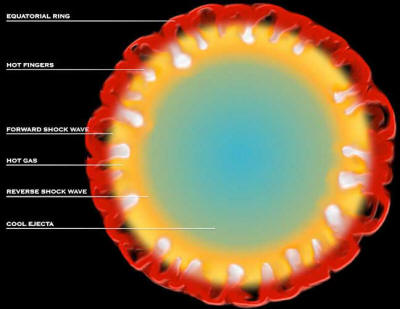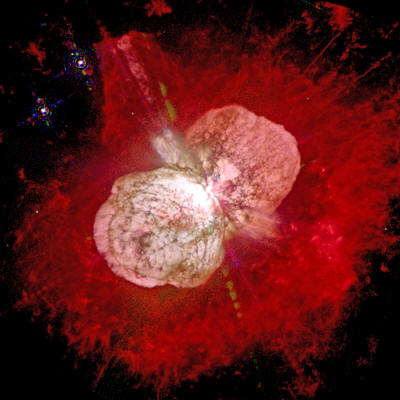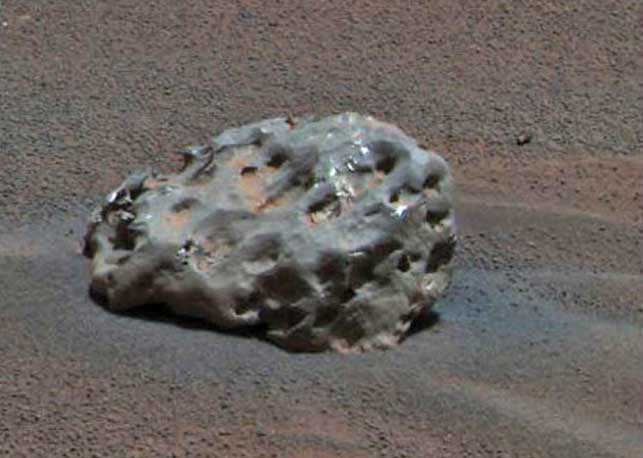|
|
|
by David Talbott from Thunderbolts Website
Nov 23, 2005
Image: The Sun
in FeXII Light
The image of the sun above was recorded in the light given off by iron atoms that have lost 11 of their 26 electrons.
The energy required to remove that many electrons is far
greater than the energy available at the surface of the sun. These
iron ions occur high in the sun's atmosphere--in the corona--where
the effective temperature is 2 million degrees or more, 400 times
that of the photosphere.
The corona is farther away from the
putative source of energy inside the sun, and it is less dense. It
should be cooler than the photosphere.
These galactic power lines are
the source of energy that "lights" the stars, including the sun. The
energy from those power lines is liberated at the photosphere rather
than being transported from the core to the surface.
They resemble, and
act like, capacitors: They store electrical energy in the strong
electrical field between the positive and negative layers.
This drift current is often called
a wind. A familiar example is the "solar wind" that drifts from the DLs near the sun to the DLs that make up the heliopause at the other
end of the sun's connection with the galactic currents.
Jan 20, 2006
This colorized
picture is a mosaic of ultraviolet images from the orbiting TRACE
satellite sensitive to light emitted
And they point to
nuclear reactions on the Sun's surface, something considered
impossible under the standard model.
Manuel
suggests that the Sun is the remnant of a supernova, now holding in
its core a "neutron star" encased within an iron shell. In this
model, most of the radiant energy of the Sun comes from the neutron
star’s slow decay over long spans of time.
This nucleosynthesis, according to Bethe, occurs through a
"Carbon-Nitrogen-Oxygen (CNO) cycle," as helium is constructed from
the nuclei of hydrogen atoms - protons - at temperatures ranging from 14
million K to 20 million K.
From this vantage point, a connection
between the hidden nuclear furnace and sunspot activity is
inconceivable.
If science operated in the way it advertises, the search for the truth in this essential matter would involve a concentration of resources to confirm or deny the evidence amassed by the Iron Sun proponents. The questions raised are crucial whether or not the proposed model of the Sun is correct.
Yet there
seems to be pressure on researchers to have a model at hand to
explain "anomalous" results. In the case of the "Iron Sun", the
result is less than perfect because there is a flaw at the very
heart of popular cosmology:
The electric force between charges mediates all physical interactions, irrespective of scale. It is the electric force that energizes matter. By ignoring electricity, cosmologists have committed an error so fundamental that the mistake invariably propagates through any and all of their theoretical excursions.
The electrical
theorists see this as the overriding cause of the oft-noted "crisis
in cosmology", and the effects on related disciplines - bound as they
are by the assumptions of cosmologists - have been nothing less than
catastrophic.
Jan 23, 2006
Credits: Crab Nebula
from VLT: FORS Team, 8.2-meter VLT, ESO; X-ray Image
In his argument for the "Iron Sun",
Oliver Manuel relies on a popular theoretical concept - the "neutron
star". Electrical theorists, on the other hand, say there is no
reason to believe that such exotic stars exist.
No conventional model of supernova remnants ever anticipated exotic structures comparable to what is seen here.
Some things are known about the Crab Nebula, however. It is close to certain that it is the result of a supernova observed from Earth in 1054 A.D.
The inner ring of the central "motor" has a diameter of about one light year. Intensely energetic jets stream outward from the central light source in two directions along the axis of an intense magnetic field.
Additionally, observations over time have
shown that rings and strands of material are moving outward on the
equatorial plane at great speeds, some up to half the speed of
light.
Having
ignored all of the things that electricity can do quite routinely,
the theorists were required to conceive a star so dense that it
could rotate at the rate of a dentists drill without flying apart.
So the neutron star received a second life. The energy of the star’s
radiation, it was supposed, came from in-falling matter from a
companion star.
In fact, all of the weird and wonderful things said
about neutron stars, such as the super-condensed "neutronium" or
"quark" soup from which they are claimed to have formed, lie outside
the realm of verifiable science. They are abstractions disconnected
from nature, but required to save a paradigm that has no other force
than gravity to provide compact sources of radiation.
They suggest that the Sun was formed by accretion of heavy elements, chiefly iron, onto a "neutron star" following a supernova explosion.
They further claim
that energy from neutrons, supposedly repelled from its neutron star
core, accounts for the Sun's radiant energy and the source of
protons in the solar wind. The model does not explain the
acceleration of the solar wind out past the planets (a crucial
requirement according to electrical experts).
The nearly 2000-fold difference in weight between the electron and the proton will ensure charge separation in an intense gravitational field. Each atom will become a tiny radial electric dipole that assists charge separation.
And the electric force of repulsion is 39 orders
of magnitude stronger than gravity, so extremely weak charge
separation is sufficient to resist gravitational compression. The
force of gravity is effectively zero in the presence of the electric
force.
The remnant of such a
discharge cannot be the imagined rapidly spinning super-dense
object: powerful electrical forces will always prevent gravitational
"super-collapse."
These concrete results do not rest on events merely imagined. And they dovetail with facts that are now inescapable: electric discharges in plasma are fully capable of generating the exotic structures of supernova remnants seen in deep space.
The "wheel and axle" form of the supernova remnant in the
Crab nebula is that of a simple Faraday electric motor. Its
structure also conforms to the stellar circuit diagram espoused by
the father of plasma cosmology, Hannes Alfvén.
They make a compelling
case against the standard solar model, and their recent findings of
electrically induced nuclear reactions on the solar surface could
open a pathway to discoveries reaching well beyond solar science.
Jan 24, 2006
Credit: NASA/STScI/CfA/P
Challis
When a star called "SK-69 202" exploded on February 24, 1987, becoming "Supernova 1987A", the shock to conventional theory was as great as the visual wonder in the heavens.
The event did not "emulate the theory", but rather appears
to have involved catastrophic electrical discharge.
Astronomers had long supposed that supernovae
occur when a star "exhausts its nuclear fuel", causing a collapse or implosion
followed by a violent "rebound" effect when the outer layers of the
star hit the core. The resulting blast, they said, ejects a
spherical shell of material into interstellar space where it
collides with its own slower moving stellar wind generated during
its earlier, more stable phases.
The bright inner ring
is about 1.3 light-years in diameter. The conventional theory of
supernovae had not predicted, or in any way anticipated, the
distinctive bi-polar structure of Supernova 1987A, similar to that
of
many nebulas now documented. Nor
did the theory have anything to say about the bright "beads".
Thus, the
"Astronomy
Picture of the Day" for July 5, 1996, states without
equivocation that "the origins of these rings still remains a
mystery".
But the crucial feature of SN 1987A is the bright beads.
Both the number and position of the beads conforms to Birkeland current filaments in a powerful plasma discharge known as a "z-pinch."
Electrical theorist Wallace Thornhill has predicted,
More than fifty years ago a British scientist, Dr. Charles E. R. Bruce (1902-1979), argued that the bipolar shape, temperatures and magnetic fields of "planetary nebulae" could be explained as an electrical discharge.
Bruce was ideally situated to make the
discovery, being both an electrical engineer versed in high-energy
lightning behavior and a Fellow of the Royal Astronomical Society.
He was ignored.
When Oliver Manuel began to formulate his model of the Sun, ideas about supernovae lay at the heart of his thinking. From a study of the unusual isotopic composition of meteorites, Manuel had concluded that the objects had formed from the remains of a supernova.
In this, he was following a tenet of conventional astronomy, which argues that elements heavier than iron and nickel in the solar system were created by distant supernovae over billions of years.
Except that Manuel concluded that the supernova creating
iron and other heavy element abundances in meteorites was the
precursor to our own Sun.
In contrast, the earlier notion of gravitationally
collapsing molecular clouds began as a theoretical guess and never
found the required observational support. Nor has it been shown how
planets can form from a ring of dust about a star, a crucial
requirement.
The sudden gravitational implosion of the entire star is an ingenious idea for a trigger but highly implausible because it requires spherical symmetry on the vast scale of a giant star. The ejections observed from supernova remnants show that the process is axially symmetric.
However, if a star is the focus of a galactic electric discharge together with internal charge stratification, it may naturally undergo an expulsive stellar "lightning-flash" to relieve the electrical stress.
An electric star has electromagnetic energy stored in an equatorial current ring such as the torus (imaged in UV light) around our Sun. As stated by electrical theorist Wallace Thornhill,
Creation of heavy metals, according to
Thornhill, does not require a
supernova. In the electric model of stars, electrical energy
produces heavy elements near the surface of all stars - a claim now
given additional support by Manuel’s own findings.
The Electric Sun model, on the other hand, says that external electrical energy, supplied from the galaxy, is responsible for producing the radiant output of the Sun, the solar wind and most of the heavy elements seen in the solar spectrum.
The production of iron atoms requires energy input. So all stars participate in the synthesis of heavy elements. (This is a far more satisfying theory than relying upon rare supernovae, which then disperse their heavy elements into deep space).
The solar wind is merely an equatorial
current sheet forming part of the circuit that "drives" the Sun. The
magnetic field of the Sun is generated by a varying direct-current
power input to the Sun. It is only to be expected, therefore, that
the observed power variations would be reflected in the sunspot
cycle and in changes in both x-ray brightness and the magnetic field
of the Sun. No mysterious "dynamo" inside the Sun could explain
these synchronous patterns.
In particular, the latter prediction fits the observed anti-correlation between neutrino count and sunspot number.
The more sunspots there
are, the fewer solar granulations and neutrinos. This unique
correlation does not fit any model that proposes an energy source
inside the Sun, unrelated to sunspots.
But since the glowing sphere we call the Sun is an electric discharge high in its
atmosphere, we should naturally expect the lightest element,
hydrogen, to predominate as the plasma medium for the discharge.
There is no need to postulate an internal source of energy to
support the photosphere since (as direct observation confirms) the
photosphere and phenomena above the photosphere, such as flares and
prominences, are not governed by gravity.
This energy may be released gradually or stored in a stellar circuit and unleashed catastrophically. The cosmic circuits now revealed threading themselves along the arms of the Milky are the energy source for the supernova explosion– not the star.
Only an external power source can explain why the continuing energy output of some nebulae such as Eta Carina exceeds that available from the central star.
A supernova does not signal the death
throes of a star. There is nothing inside the star to "die." Nor
does it herald the birth of a neutron star.
Jan 26, 2006
Credit: http://oz.plymouth.edu/~sci_ed/Turski/Courses/Earth_Science/Intro.html
In his "Iron Sun" theory, Oliver Manuel has developed an unorthodox answer to puzzles concerning the birth of the solar system, recorded in meteorites and lunar samples.
But
in interpreting these samples, he has fallen prey to a conventional
myth as to their origins.
Within this disk, the Sun formed at the center and all of the secondary bodies from planets and moons down to asteroids, comets, and meteorites accreted from leftover debris.
Plasma cosmology provides the simple answer to the question of how stars are formed.
They are formed by the powerful and long-reaching electromagnetic force of a
"plasma pinch", a principle well
researched in the laboratory and now observed in detail in high
resolution images of planetary nebulae.
In this view it is not correct to look to gravity as the cause of star formation. It is also normal for a number of stars to be formed along the axis of the plasma pinch and subsequently scatter "like buckshot" following the collapse of the pinch.
Planets are generally not formed at this
stage. We should expect that stars formed in this manner would, as a
group, tend to have their rotational axes aligned along the
direction of the galactic magnetic field.
That explains both the preponderance of multiple star
systems and the close-orbiting gas giants. Rocky planets and moons
are similarly born at intervals by means of electrical expulsion
from gas giants. Rings about gas giants and stars are principally a
result of electrical expulsion, not gravitational accretion.
Planets and moons are charged objects, and subsequent encounters in an unstable system can leave surfaces dominated by electrical craters, vast trenches, and other scars. Much of the excavated material can then be lofted by the discharge into space as comet nuclei, asteroids, and meteorites, while portions of the material may fall back to form strata of shattered rock and loose soil.
Electrical interactions
between planets also have the beneficial effect of quickly restoring
order out of chaos.
As rocky surfaces are excavated electrically, for example, the
resulting short-lived radioactive isotopes may wind up in the grains
of meteorites.
We have already suggested that Oliver Manuel,
in developing his argument for the "Iron Sun", was too willing to
accept orthodox assumptions.
But
in this case the more telling facts may relate to lunar soil
isotopes that do not appear in the solar wind.
But the idea that either the Sun or any other body in the solar system is the remnant of a supernova is unnecessary. There is no necessary connection between supernovae and meteorite isotopes. In fact, it was suggested long ago that the many strange features of meteorites could have been formed in gargantuan lightning flashes within a solar nebula.
And Manuel has noted that grains in the Murchison meteorite have isotope abundances related to grain size that,
The Electric Universe model satisfies both ideas.
In these pages, we have documented the recent electrical sculpting of planets by cosmic scale discharges in the solar system.
We have suggested that meteorites are the debris of planetary encounters, a conclusion now
supported by direct observation of planetary surfaces and by the
study of meteorites, the latter revealing the effects of flash
heating, ion implantation, and the isotopic anomalies that would be
expected from an interplanetary thunderbolt.
And there is good reason why virtually every rocky body in the solar system shows evidence of catastrophic encounters. The history of the solar system is one of "punctuated equilibrium" – long periods of stability punctuated by brief episodes of chaos as new members are accommodated.
The fact that no simple gradation of
planetary characteristics occurs within the solar family needs no
other explanation.
|


